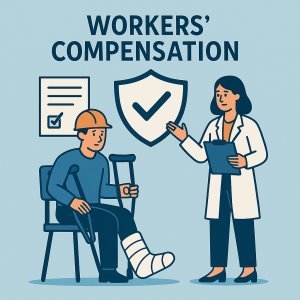
Navigating the workers’ compensation claim process can be complex and time-consuming for employers. Understanding each step-from initial injury reporting to claim resolution-is essential to ensure compliance with legal requirements, support employee well-being, and manage costs effectively. This article offers a comprehensive, step-by-step guide to the workers’ comp claim process, designed to help employers streamline their approach, minimize disruptions, and maintain a safe workplace environment. Whether you are new to managing claims or seeking to enhance your existing procedures, this detailed overview will provide the clarity and confidence needed to handle workers’ compensation efficiently.
Table of Contents
Understanding Employer Responsibilities in the Workers Comp Claim Process
Employers play a crucial role when a workers’ compensation claim arises,carrying the responsibility to act swiftly and efficiently to ensure compliance and support the injured employee.Upon notification of a workplace injury, it is imperative for employers to document the incident thoroughly and report the claim to their insurance provider within the statutory timeframe. This documentation frequently enough includes the injury report, witness statements, and initial medical evaluation. Failure to adhere to these reporting requirements can result in penalties and delays in claim processing,which may increase liability risks.
Additionally, employers must facilitate a safe and supportive return-to-work program. This includes accommodating medical restrictions and maintaining clear communication with both the employee and the claims adjuster to monitor the progress of recovery.Below is a summary of key employer responsibilities in the claims process:
- Prompt reporting: Notify insurance carrier and state authorities promptly
- Accurate record-keeping: Maintain thorough injury and treatment records
- Communication: Keep open lines with injured worker and medical providers
- Return-to-work coordination: Develop modified duty assignments as appropriate
- Compliance: Follow all legal and regulatory requirements governing workers’ compensation
key Documentation and Reporting Requirements for Efficient claims Handling
Accurate and timely documentation is crucial for streamlining the workers’ compensation claim process. Employers should prioritize gathering comprehensive incident reports immediately after an injury occurs, which include the employee’s statement, witness accounts, and photographic evidence if available. Additionally, keeping detailed records of medical evaluations and treatment plans helps ensure clarity between all parties involved-medical providers, insurance carriers, and legal representatives. effective documentation not only supports the claim’s validity but also expedites decision-making and reduces the potential for disputes or delays.
Consistent reporting protocols are equally crucial.employers must adhere to state-specific deadlines and maintain clear communication channels internally and with insurance adjusters. The following outlines essential documentation and reporting elements to maintain efficient claims handling:
- Initial Incident Report: Includes date, time, and description of the injury
- Employer’s Report of Injury: submitted to the insurance carrier within required timelines
- Medical records: Diagnosis, treatment dates, and prognosis details
- Return-to-Work Documentation: Any restrictions or accommodations recommended by healthcare providers
- Ongoing Communication Logs: Notes from interactions with the injured employee and insurance representatives
| Document Type | Required By | Typical Deadline |
|---|
| Incident Report | Employers | Within 24 to 72 hours |
| Employer’s Injury Report | Insurance Carrier | Within 7 days |
| Medical Evaluation Summary | Healthcare Providers | Upon each visit |
| Return-to-Work Clearance | Employers/HR | Before employee resumes duties |
Collaborating with Insurance Providers to Ensure Compliance and Timely Resolutions
Effective communication with insurance providers plays a pivotal role in managing workers’ compensation claims efficiently. It’s essential to establish clear channels of dialogue early in the process to ensure all parties are aligned on expectations, documentation requirements, and timelines. Employers should prioritize sharing precise and thorough facts, such as injury reports and medical evaluations, to prevent delays caused by incomplete or inaccurate submissions. Additionally, leveraging technology like claim management software can streamline interactions and assist in tracking the progress of a claim, fostering clarity and swift decision-making.
To maintain compliance and facilitate timely resolutions, employers must also be proactive in understanding the specific policies and regulatory frameworks that govern their insurance partnerships.Regular training sessions for HR and management teams on compliance updates, combined with scheduled meetings or check-ins with insurers, can mitigate risks associated with miscommunication or overlooked deadlines. Below is a snapshot comparison of critical compliance checkpoints and insurer responsibilities that employers should monitor:
| Compliance Checkpoint | Employer Responsibility | Insurance Provider Role |
|---|
| Injury Reporting | Report within 24 hours | Confirm receipt & initiate claim |
| Documentation Submission | Provide full medical records | Review and assess authenticity |
| Claim Status Updates | Request updates regularly | Communicate progress promptly |
| Compliance Training | Ensure staff participation | Supply regulatory guidelines |
Strategies for Preventing fraud and Managing Claims Costs Effectively
Minimizing fraudulent claims and controlling claims costs require a proactive, multifaceted approach. Employers should start by fostering a culture of transparency and accountability where employees feel comfortable reporting incidents promptly and honestly. Implementing thorough claims verification procedures-including detailed investigations, medical evaluations, and cross-checking claim details-can significantly reduce false claims. Additionally, leveraging technology such as claims management software and data analytics helps detect irregular patterns early, allowing swift intervention.Effective cost management also involves establishing clear communication channels between all stakeholders-employers, insurers, healthcare providers, and employees. Consider adopting these best practices to safeguard your institution:- Early Return-to-Work Programs: Support injured employees in resuming work through modified duties, reducing downtime and associated costs.
- Regular Training: Equip supervisors to identify potential fraud indicators and enforce safety protocols.
- Consistent documentation: Maintain comprehensive records throughout the claim lifecycle to ensure accuracy and compliance.
- Collaboration with Experts: Engage third-party investigators or legal counsel when suspicions arise to validate claims objectively.
| Strategy | Key Benefit | implementation Tip |
|---|
| Claims Auditing | Reduces fraudulent payouts | Review claims quarterly |
| Employee Education | Promotes honest reporting | Conduct annual workshops |
| Technology Integration | Improves detection accuracy | Use AI-based claim analysis |
Q&A
Q&A: The Workers’ Comp Claim Process Explained step-by-Step for Employers
Q1: What is workers’ compensation insurance, and why is it important for employers?
A: Workers’ compensation insurance covers medical expenses and lost wages for employees who suffer work-related injuries or illnesses.It is legally required in most states and protects both employees and employers by providing a structured claims process and limiting liability exposure.Q2: What should an employer do immediately after an employee reports a workplace injury?
A: Employers should ensure the injured employee receives appropriate medical attention, document the incident thoroughly, and provide the employee with any required claim forms promptly. Immediate response helps facilitate a smooth claims process and demonstrates compliance.
Q3: How does the initial reporting process work?
A: Once an injury is reported, the employer must notify their workers’ compensation insurance carrier within a specified timeframe, usually within 24 to 72 hours. This notification includes details such as the employee’s information, injury description, and circumstances surrounding the incident.
Q4: What role does documentation play in handling a workers’ compensation claim?
A: Accurate and detailed documentation is critical. It verifies the claim’s legitimacy, supports the insurer’s investigation, and protects the employer against fraudulent or exaggerated claims. Employers should keep records of medical reports, witness statements, and any communication with the employee and insurer.
Q5: What are the employer’s responsibilities during the insurer’s investigation?
A: employers should cooperate fully by providing requested documentation, clarifying the work conditions, and offering any additional information that can definitely help determine claim validity. Open communication with both the insurer and the employee aids in resolving claims efficiently.
Q6: How can employers support injured employees throughout the claim process?
A: Employers can promote a culture of safety, facilitate timely medical care, maintain regular communication with the employee, and offer modified or light-duty work options when appropriate. Providing support can improve recovery outcomes and reduce claim costs.
Q7: What happens after the claim is accepted or denied?
A: If accepted, the insurer will begin paying medical benefits and wage replacement to the employee as stipulated by law. if denied, the employer must inform the employee of their right to appeal, and both parties may engage in dispute resolution processes. Employers should ensure all legal notifications and procedural requirements are met.Q8: How can employers minimize future workers’ compensation claims?
A: Implementing proactive safety programs, conducting regular employee training, performing workplace hazard assessments, and fostering a safety-first environment are effective strategies. These initiatives reduce the risk of injury and demonstrate due diligence in workplace safety.
Q9: What are common pitfalls employers should avoid during the workers’ comp claim process?
A: Delaying injury reporting, failing to document incidents properly, neglecting communication with the injured employee or insurer, and retaliating against employees for filing claims are critical mistakes. These errors can lead to legal penalties,higher insurance premiums,and reputational damage.
Q10: Should employers consider outsourcing workers’ compensation claim management?
A: Many employers find value in partnering with specialized third-party administrators or legal counsel who can navigate complex claims processes, ensure compliance, and optimize outcomes.Outsourcing can be especially beneficial for businesses without dedicated HR or risk management resources.
The Conclusion
understanding the workers’ compensation claim process is essential for employers to ensure compliance, support injured employees effectively, and mitigate potential risks. By following the outlined steps-promptly reporting incidents, documenting thoroughly, cooperating with insurers, and facilitating timely medical care-employers can navigate claims smoothly while maintaining a safe and productive workplace. Staying informed and proactive not only protects your business but also demonstrates a commitment to employee well-being, which is vital for long-term organizational success.
“This content was generated with the assistance of artificial intelligence. While we strive for accuracy, AI-generated content may not always reflect the most current information or professional advice. Users are encouraged to independently verify critical information and, where appropriate, consult with qualified professionals, lawyers, state statutes and regulations & NCCI rules & manuals before making decisions based on this content.”










